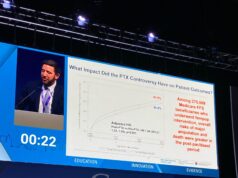Boston Scientific’s spherical embolisation agent is able to provide adequate uterine fibroid infarction. Richard Shlansky Goldberg presented the data at a satellite symposium organised by the company at CIRSE 2010, October, Valencia, Spain.
“Contour SE PVA microspheres give adequate uterine fibroid infarction when the appropriate endpoint is used,” Shlansky-Goldberg, associate professor of Radiology, told delegates.
Importantly, the results of this study seem to “go against the grain” when compared to previous studies by Spies et al (randomised, 2005) and Gary Siskin (randomised, 2008) and Abramowitz et al (non-randomised, 2009) all of which have found Contour SE to be inferior to Embospheres. There are, however, differences in the studies regarding the size of the Contour SE particles, mean uterine volumes of patients and embolisation endpoints, said Shlansky Goldberg.
The session was titled Controversies in UAE: A controlled, randomised study comparing Contour SE microspheres to Embosphere microspheres for uterine artery embolisation.
Shlansky-Goldberg and investigators set out to look at both dominant and non-dominant fibroids to try and tease out how Contour SE microspheres (Boston Scientific) which are spherical polyvinyl alcohol microspheres and Embosphere microspheres which are tris-acryl gelatin microspheres (Biosphere Medical) work. The primary endpoint of the study was leiomyoma devascularisation measured by contrast enhanced MRI at 24 hours post UAE.
Secondary endpoints were fibroid specific quality of life measures at three months, maximum level of nausea and pain measured using the visual analogue scale at 24 hours, fluoroscopy and procedure time and adverse events in hospital post-procedure.
They found that dominant and non-dominant fibroid infarction at 24 hours is equivalent between 700-900 micron Contour SE and Embosphere, when a five cardiac beat endpoint with no forward progression past the horizontal segment of the uterine artery rule is used for Contour SE. The “pruned three” end point was used for Embosphere. They also found that quality of life, fibroid infarction and the other secondary endpoints are similar between these two agents at three months.
Investigators enrolled 62 patients, two of which withdrew from the study. They then randomly allocated 30 patients to the group who were receiving uterine artery embolisation with Contour SE particles (group A) and 30 patients to those receiving UAE with Embospheres (group B). Shlansky-Goldberg explained that “At the end, at 24 hrs follow-up, we had 29 patients in group A, and 30 people in group B. Then, at three months follow-up we had 28 people in group A (93.3%) and 28 patients in group B (96.7%). Both groups were similar, dominant fibroid volumes were similar, fibroid locations are also similar.”
Shlansky-Goldberg told delegates that in terms of total fluoroscopy time (group A=31+/- 19 minutes, group B 25+/-8.7 minutes), total procedure time (group A=102+/- 50 minutes, group B 96+/-39.6 mins) number of syringes/vials used, and length of hospital stay, the two groups did not present statistically significant differences.
Results
“At 24 hours, with regard to the dominant fibroids, 29 out of 29 were completely infarcted in the Contour SE group. Similarly, 28/30 were infarcted in the Embosphere group. This resulted in a difference of 6.7%,” Shlansky-Goldberg said.
“In summary, we have demonstrated non-inferiority, because there was significant non-inferiority with a p value of 0.001. Statistically, you cannot say that the two behaved the same, but you can say that Contour SE was non-inferior with a high p value,” he said.
“There were no significant differences in terms of outcomes of infarction rate of the dominant fibroid at three months, and no significant differences in terms of the secondary endpoints. At 24 hours, the non-dominant fibroids were either 100% infarcted or not infarcted at all. This held true for those less than 2 cm in diameter and also for the larger ones. This result also held true at three months larger leiyomas were either 100% infarcted or not infarcted at all,” he pointed out.
When comparing the results of this study with previous data, Shlansky-Goldberg, clarified that James B Spies et al’s 2005 study used 500-700 micron spherical PVA and showed that it was inferior. “The difference in this study was that, we upsized, we used 700-900 micron,” he said. He also compared it with Gary Siskin et al’s 2008 study which compared 700-900 micron spherical PVA to show that it was inferior. “In this study, our endpoint was almost complete stasis for five beats. Some might say that this is overembolising. This was a point of difference, and also in Siskin’s population, the uteri were about a third smaller in volume. I am not sure how these issues might have affected outcomes,” he said.
“Spherical PVA gave adequate uterine fibroid infarction when the appropriate size and endpoint was used in this prospective randomised trial,” concluded Shlansky-Goldberg.
James B Spies, who was present in the audience, said it was an excellent study. He commented that the endpoint in the previous studies were probably not as aggressive as in this one and asked Shlansky-Goldberg if he had difficulty in reaching this endpoint. To this, he replied,“Generally speaking, no.” Then Spies asked if the results meant that Shlanksky-Goldberg would be sticking with old style PVA for UAE. To this, the latter replied,“It is always a tough choice. By sticking to a very aggressive endpoint, we do not have the issues that we had before.”












